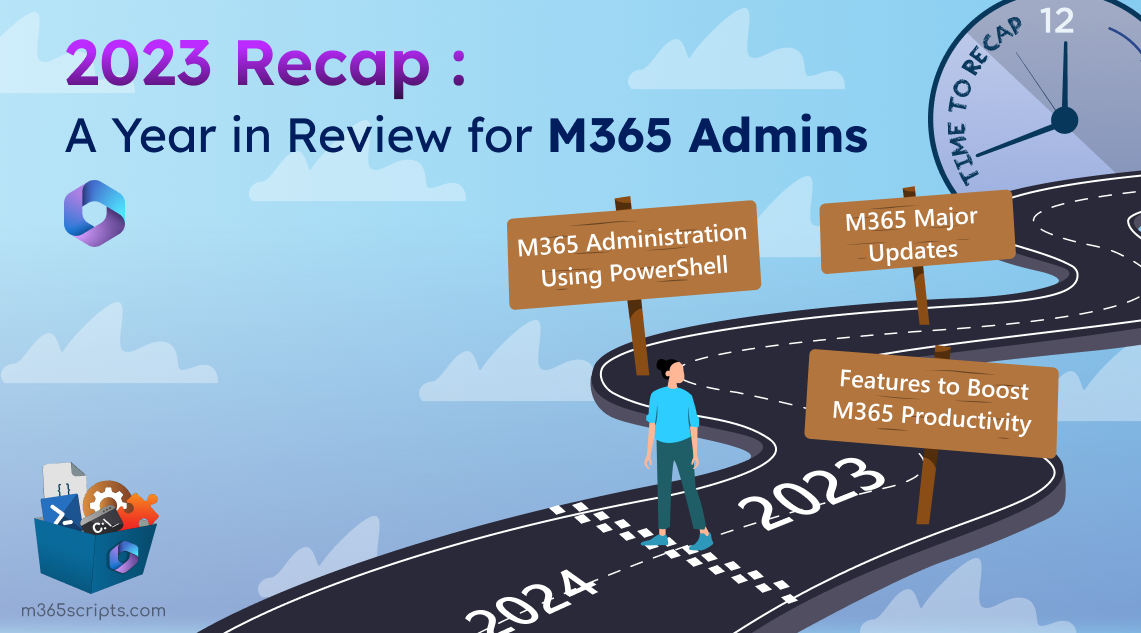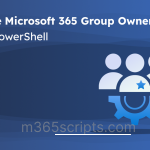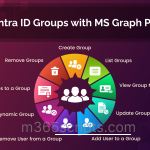
2023 Recap: Top Microsoft 365 Administration Blogs
As we step into the new year, let’s take a moment to look back at our top blogs of 2023 🎉. From crucial updates to useful PowerShell management tips, these resources have empowered countless admins to maximize their potential in Microsoft 365 administration.
We have categorized our top blogs that we highly recommend revisiting before stepping into 2024 into the following categories:
- Microsoft 365 major updates and retirements
- Features that boost Microsoft 365 productivity
- Key practices for efficient Microsoft 365 administration
- PowerShell for enhanced Microsoft 365 management
Microsoft 365 witnessed significant 🆕 updates in 2023 that meet digital transformation needs. Now, let’s explore the most-talked list of the year!
Meetings are a part of every office, yet remembering key points discussed during those meetings can be challenging. Microsoft’s meeting recap feature in Outlook web acts as a virtual rewind button, boosting productivity in Teams meetings. It offers a straightforward method to access post-meeting content, including recordings, transcriptions, and files, directly from the Outlook calendar event. This innovative update minimizes the need for storage, ensuring a seamless and efficient approach to managing meetings.
Additionally, the MS Teams Premium feature – intelligent meeting recap, enhances collaboration with its AI-driven meeting summaries. Distinguishing itself from standard recaps, the intelligent recap includes detailed analysis, automatic chapter creation, and task recommendations for thorough and efficient reviews. This groundbreaking addition transforms meetings into productive experiences by offering advanced capabilities such as indicating missed parts and providing a list of the most frequent speakers. It also offers quick links to enrich the overall collaborative environment.
Microsoft Teams brings a fresh perspective to virtual meetings through its green screen feature. The green screen feature in Teams meetings allows users to replace their actual background during video calls with a virtual background of green color. This upgrade ensures clearer visibility of your face and held objects, imparting a professional look to your meetings. This creative feature is currently available only on Windows and macOS devices with Intel chips.
Microsoft has announced a change that directs web links from Microsoft Teams chats to open in Edge by default. While Microsoft emphasizes a side-by-side experience for links from Outlook emails and Team chats, this move has sparked controversy among users for overriding default browser settings. Users and admins can configure policies to maintain their preferred default browser and stop Teams chat links from opening in Microsoft Edge.
In response to Microsoft’s deprecation of PowerShell modules like Azure AD and MS Online, admins have turned their attention towards the MS Graph PowerShell module. While the Microsoft Graph module offers valuable attributes, some critical properties are only accessible through the beta profile of the PowerShell module. With the Graph PowerShell module update to version 2.0, Microsoft has separated beta from the standard version.
The installation of the Microsoft Graph beta module provides seamless access to beta features without the need to switch profiles each time. By prefixing the cmdlets with “Beta”, admins can explore comprehensive beta features and benefits.
The deprecation of Remote PowerShell (RPS) in Exchange Online marks a significant change for admins who rely on this tool. The retirement of Exchange Online remote PowerShell necessitates admins to use alternative versions of the module to fulfill their management tasks. This blog outlines how to identify current Remote PowerShell usage and provides steps to transition away from RPS. It also explores the option to re-enable RPS temporarily and discusses the timeline for the deprecation process.
Here’s a recap of the standout features that empowered Microsoft 365 users to excel in their work. 🚀
Setting up the Microsoft 365 group expiration policy is a valuable strategy for efficient group management to reduce clutter and improve overall visibility. This policy empowers admins to automate the removal of groups that are no longer needed. This policy triggers automatic renewal whenever a user within the group engages with Microsoft 365 group services. In essence, incorporating this feature is crucial for effective Microsoft 365 administration.
Microsoft Teams connect shared channels revolutionize external collaboration by eliminating the need to switch tenants for collaborating with external organizations. This feature streamlines conversations, file management, and workflows, allowing users to collaborate seamlessly with other teams and organizations. The scalability is even impressive with the ability to create 200 shared channels, each accommodating 50 teams and 5000 direct members. Using PowerShell and the Teams admin center, admins can efficiently configure shared channels and enhance Microsoft 365 administration for cross-organizational collaboration.
The M365 archive and deletion policy is a powerful feature of Messaging Records Management (MRM) retention that empowers automated mailbox optimization. Offering an alternative to advanced licenses for mailbox expansion, this policy facilitates secure backup and deletion of non-essential old emails. The process includes enabling archive mailboxes, configuring archive and deletion policies, creating retention tags, and establishing retention policies. Admins can even customize these policies based on their organization’s needs for effective storage management.
Optimize your Microsoft 365 administration with the following power solutions and take your management practices to new heights. 📈
In optimizing M365 management and effectively minimizing operational complexities for admins, Microsoft Power Automate emerges as a transformative and essential tool. This blog on Microsoft 365 user onboarding using Power Automate assists you in everything from effortlessly gathering user details in a SharePoint list to creating new users in Azure AD. The brilliance lies in its ability to seek manager approvals, ensuring a structured workflow.
This enhanced approach not only speeds up user provisioning but also minimizes errors, offering a robust solution for modern organizations seeking efficiency in their Microsoft 365 user management.
In the Exchange admin center, the dynamic distribution groups report marks a significant enhancement, offering a comprehensive overview of group usage and activity. This user-friendly interface allows you to filter by date and sort groups by usage.
Furthermore, admins can anticipate forthcoming updates by accessing creation details, the last refresh time, and the next scheduled refresh. With this user-friendly interface, managing and analyzing dynamic distribution groups in Microsoft 365 will become simpler and more insightful.
Streamlining admin tasks is crucial for common scenarios like user offboarding or tenant migration. In such situations, exporting mailboxes to PST through eDiscovery and PowerShell eliminates the need for external tools. Whether managing an individual mailbox or the entire package, this step-by-step guide covers assigning eDiscovery administrator roles, conducting content searches, and exporting mailbox data. Once completed, the results can be effortlessly exported to PST files, and downloaded via the Microsoft Office 365 eDiscovery Export Tool.
Tired of repetitive tasks? Let PowerShell take care of the heavy lifting! These PS management operations will free up your time for what matters most! ⌛️
Streamline your Microsoft 365 Entra ID management with the efficiency of PowerShell, particularly by leveraging the Microsoft Graph PowerShell SDK. As your user base expands, these cmdlets empower admins with seamless bulk operations, surpassing traditional modules like Azure AD. From M365 user management to group management using PowerShell, this module aligns with Microsoft’s future direction, ensuring a smooth and efficient administrative process.
For utmost security in your Microsoft 365 user accounts, you can use the versatility of password management using Graph PowerShell. This integrated approach provides a comprehensive solution for managing user identities.
Effective management of MS Teams is crucial to ensure smooth and effective communication within organizations. Utilize these top 10 Graph PowerShell cmdlets to manage Teams such as adding or removing members of a team and creating or deleting channels. For seamless collaboration and contributions with other teams and external organizations, leverage the Teams shared channel management using PowerShell cmdlets.
Efficiently managing the SharePoint Online recycle bin is crucial for avoiding accidental deletion of important files and optimizing storage. The PnP PowerShell module offers a robust solution for this. It guides admins on navigating the second stage recycle bin using commands for search, restore, and deletion. Moreover, connecting to SharePoint Online through PnP PowerShell enables efficient tracking of storage, retrieval of specific items, data governance, and site performance optimization.
PowerShell is an effective ally for controlling SharePoint Online site users and groups. From retrieving SharePoint sites to creating, updating groups, and adding/removing users, this guide covers it all. PowerShell facilitates the management of SPO users and groups by generating fine-tuned reports on SharePoint users and groups.
Exchange Online PowerShell proves to be an invaluable companion when it comes to simplifying the workload of manual mailbox management. You can efficiently handle and proactively manage Microsoft 365 mailboxes in PowerShell using these top cmdlets. Further, monitoring Exchange emails with effective PowerShell scripts can be used to track mail traffic, detect delivery status, and enhance mailbox security.
Organizations often rely on room mailboxes within Exchange Online to streamline meeting processes. Managing these rooms is crucial to ensure efficient use of meeting spaces and avoid scheduling conflicts. Fortunately, PowerShell simplifies room mailbox management in Exchange Online. In addition to basic room management tasks, Exchange Online PowerShell offers the following advanced operations:
Allow External Users to Book Meeting Rooms: Partners or clients from diverse organizations may face challenges in booking meeting rooms within your organization. In such scenarios, enabling external users to book meeting rooms using PowerShell fosters a more inclusive and flexible collaborative environment. This facilitates a seamless interaction between internal teams and external contributors for partnership contributions.
Block Meeting Room Bookings: Ensuring optimal utilization of meeting resources requires the ability to block meeting room bookings using PowerShell. This allows you to limit and block access to meeting rooms in Exchange Online effortlessly!
In conclusion, the 2023 recap on Microsoft 365 administration underscores the transformative journey, major updates, and feature enhancements within Microsoft 365. Cheers to the ongoing evolution of Microsoft 365 administration to meet the dynamic demands of the digital era. Stay tuned with us for more Microsoft 365 management-related tips and guides. 🚀 Happy New Year! 🎈







